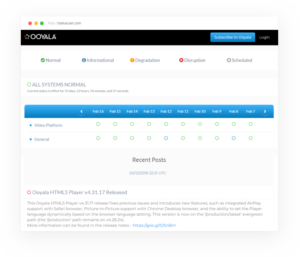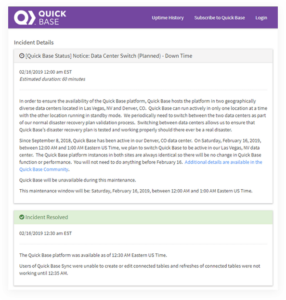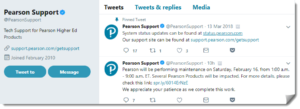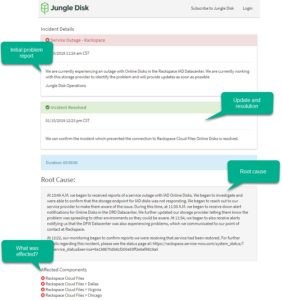Products
Features
Solutions

A site under maintenance can be stressful for employees and customers. In our fast paced and hyper-competitive business environment, pulling through unharmed from a difficult situation requires a lot of effort, communication and teamwork. Often the level of effort required to ensure things run smoothly goes unnoticed by those on the outside of your organization.
In many situations, users have little understanding or appreciation of the work required by your IT team to keep a Site running smoothly, correctly and without glitches.
This is especially true with regards to a website under maintenance.
In many situations, there is a whole team working in the background (sometime around the clock) to promptly restore your Site and critical applications.
In today’s ever-increasing reliance and complexity of technology, security concerns, DDoS attacks and desire to provide users with the latest and greatest, encountering a website down for maintenance is unfortunately occurring with an alarming frequency. The impact on your company’s brand and market perception, end-user satisfaction, additional workload on your customer service team as well as a potential revenue loss could be devastating.
Since the question is no longer “if this will happen” but “when will this happen?”, your organization has an opportunity to proactively develop a game plan and process by deploying an “under maintenance page” that reflects the branding and end-user responsiveness you have worked so hard to build and maintain.
How your IT team responds and reacts to planned or unplanned site maintenance can create a positive or negative perception of your entire organization.
Given the choice, why not use a potentially negative situation as an opportunity to further showcase your company brand and ability to communicate with your employees and customers via a website down for maintenance message that’s different?
In addition, by staying ahead of the situation, you are in a much better position to remain focused on resolving the matter so you can move onto more strategic tasks.
Adopt and deploy this 9-step proven plan to remain in control of your maintenance messaging, keep your employees and customers in the loop, and preserve the brand, image and reputation you have worked so hard and long to build.
Have a clearly planned pathway on your site to quickly and intuitively direct users to a status maintenance page where they can get current information anytime. An outlined roadmap hyper-linked at several prominent and easily accessible places on your site can reduce or eliminate over burdening your customer service department with inbound inquires during an outage. Taking the initiative by being proactive can help to further enhance your positive customer service.

Before posting an update, be sure to conduct internal testing to determine and conform the root-cause of the issue. This helps ensure that the information you share with others on your web maintenance page is reliable and accurate-further enhancing the trust and credibility of your organization.
A consistent flow of reliable, accurate and timely information during critical down times is critical to minimizing the potential for a disastrous situation to spin out of control. Provide estimated down for maintenance time frames and update your projections as new information becomes available. Post scheduled updates even if there’s no new developments with a “still working on this” maintenance message to keep users informed that you are aware of and working on resolving the issue.
If you’re unsure how long until the issue will be resolved, provide status updates at planned ongoing times on your status maintenance page. For example, you could post hourly or every 30 minutes with a preview of your next steps or share your pathway to issue resolution.
“People feel better when they know what to expect, and you want your brand image and reputation to stay solid at all times in the eyes of your users and stakeholders.”

Without confusing your users with irrelevant technical details, or overwhelming them with information that is not relevant, simply provide a high-level issue overview or summary; then explain how it affects users and what they can expect to happen next. Having and sharing your game plan helps instil confidence that you have the situation under control. If possible, give your users a way that they can obtain more technical information. However, most users appreciate messaging and updates that are concise and informative and written in a manner that they can quickly and easily get an understanding of the situation.
With an engaging and customer-focused web maintenance page, you have another opportunity to further enhance and solidify your brand or company persona. Having the ability to tailor or customize the colours and look and feel of this page allows you to maintain your brand across all the web properties that a customer or employee may encounter. It’s this consistency in engagement points that build and reinforce your brand by forging a common familiarity with people that visit your Site Under Maintenance page. The ability to portray a consistent brand image and message, also helps reinforce all of the hard work, money and effort exerted by your Marketing department.

With the rising usage and potential expose via social media, you can leverage these channels to send routine website maintenance messages or information on external down for maintenance fixes (not internal work).
Since users frequently turn to these sites for company information and updates, they can serve as an additional platform to expand the reach of your site maintenance message or messages.
These site can also help to create the perception that your company is using all available means to notify and inform users about site maintenance issues. It’s even possible to integrate this process with your main social media accounts like Facebook, Twitter thereby offering almost real-time updates to your employees and customers.

There is no better time to shine then when you are under pressure. Many find that keeping things in perspective and light hearted can minimize the frustration that often arises from not knowing or feeling that you are being left in the dark. Being accountable, taking responsibility and providing a channel for open communication goes a long way to calm the situation. Some organizations deploy applications such as HelpScout, a tool that offers conversation tips and suggestions to support staff. In a bad situation, people often look to you to determine the severity of the situation, and how they should react. By setting the proper tone, leading by example and communicating, you can help diffuse a bad situation and minimize the potential for things to escalate and spin out of control.
There is no better time to shine then when you are under pressure. Many find that keeping things in perspective and light hearted can minimize the frustration that often arises from not knowing or feeling that you are being left in the dark. Being accountable, taking responsibility and providing a channel for open communication goes a long way to calm the situation. Some organizations deploy applications such as HelpScout, a tool that offers conversation tips and suggestions to support staff. In a bad situation, people often look to you to determine the severity of the situation, and how they should react. By setting the proper tone, leading by example and communicating, you can help diffuse a bad situation and minimize the potential for things to escalate and spin out of control.
There is no better time to shine then when you are under pressure. Many find that keeping things in perspective and light hearted can minimize the Make sure you always follow up with your users to ensure a closed loop process and to provide you with feedback for continual process improvement. If you were able to identify the root cause of the issues, it’s always a good idea to share your plan to make sure this same issue does not happen again. Use this event to raise your credibility by being transparent and providing the correct information to the correct people. Frequently review your policies and procedures for a Site Under Maintenance to make sure they meet the demands and needs of your ever-changing business and users. Striving to be the best is a journey of continual incremental improvements of a long period of time.

Be a super hero to your users and Executive Management team by deploying a branded website maintenance page ( or down for maintenance page) that showcases your pride in your company and commitment to your profession. Find out more about public status pages and private status pages by following the links.
Customer service used to be solely about calling a 1-800 number and listening to elevator music for 8 minutes until a representative picked up. Not anymore. According to Customer Thermometer’s Customer Service Stats for 2019:
At the rate we’re moving and with Millennials becoming a significant buying cohort, online customer service may replace call centers (and elevator music) in the future. Users will be engaged by tech support before they even know they have a problem. Instead of turning to their telephone, consumers will turn to Google to find the answers they’re looking for.
Online customer service is a critical differentiator for business-to-business and business-to-consumer brands.
67% of consumers and 74% of business buyers say they’ll pay more for a great experience. Salesforce
While brands are under increasing pressure to deliver superior online customer support, they are faced with the fact that online service is far more complex than simply responding to emails and picking up the phone. It’s an all encompassing online strategy, a method for helping customers find the answers they need quickly and efficiently.
To help brands achieve excellence in this critical customer-facing function, we’ve shared our 8 Keys to Mastering Online Customer Service.
A Comprehensive FAQ Page
A comprehensive frequently asked questions, or support page is the backbone of any online customer service initiative. This is especially true in our case. we sell a product (IT status pages) that people may or may not know exactly how to use.
Another benefit of a thorough FAQ page is the time freed up for employees who would typically handle customer service calls or emails. Of course, there will be times when a customer has a legitimate question or a unique challenge that requires answering, but in our experience the vast majority of callers ask the same five or six questions, which can be quickly answered on a support page.
Install Live Chat Software
Live chat software has limitless potential for your business. Why?
It’s a convenient way for users to get answers to questions. The number one reason people leave websites (and don’t purchase your product or service) is because they can’t find the answers they’re looking for.
It does not impact design. It can hide subtly in the corner of your website, like ours does.
It helps boost sales. Forrester Research concludes that live chat increases online sales by 105%….that’s alot!
It provides insight into customer frustrations. If you find that customers are often asking the same question you may be able to identify a company or site wide issue requiring immediate attention.
Utilize Social Media Software
Leveraging social media software like Hootsuite breathes life into your brand’s online profile. We’re in the midst of a true brand expectation renaissance. Consumers don’t want to be marketed to, they want to engage with their favorite brands on their “own terms.”
In terms of online customer service, social media software allows you to monitor multiple networks, boosting responsiveness with customers and prospects. Social media software also gives you the opportunity to respond to customer frustration and offer a solution. More often than not, when users post to social media with complaints or frustrations – a friendly message or comment can turn negative online public relations into masterful online customer service.
Website User Experience
User experience and customer service are increasingly intertwined. So much so that customer user experience has become a mainstream term. Customer user experience is the all encapsulating phrase describing a customer’s journey from discovery, to purchase, to use. There are a few things you can do on your website to enhance customer experience.
Configure Google Analytics Site Search
Ensure Google Analytics is installed and configured on your website (if you don’t have it setup, we highly recommend doing so). Leveraging your site search data is a powerful tool for valuable user insight. Knowing what visitors are looking for within your site answers a lot of questions you may have. Is my navigation bar useful? Does my website contain all of the content that people are searching for? You can also use the site search data to discover new content ideas and find questions to add to your FAQ page.
Be Human. Be Helpful
It’s easy to overlook being personable and genuinely wanting to help someone and improve their online customer service experience. Having an employee on the other line of a customer service call isn’t enough anymore. Support representatives should be incentivized and actually want to help customers.
Some web users, especially older ones, find it hard to trust online fronts due to the lack of a human interaction. Be sure to include your face and your employees’ faces on your website. Let users know that they are purchasing a product or a service from an actual person just like them.
Online Customer Testimonials
Marc Zuckerberg said it best “People influence people. Nothing influences people more than a recommendation from a trusted friend”. Although your customer testimonials may not feature a trusted friend, its still a very effective way to build brand trust.
90% of customers are influenced by positive reviews when buying a product. Zendesk
The best way to get online customer testimonials is to reach out to satisfied customers and ask them for a testimonial (you don’t get anything in life if you don’t ask for right?). Encourage them to speak candidly about their experience, the product or the service provided. Be sure to reward customers who offer testimonials, it’s well worth the cost.
Offer Knowledge
If a customer were to walk into a shop needing assistance, they would quickly be able to discern which employees are knowledgeable about their products and which aren’t.
The same is true for online customer service in your digital store. Users can tell when content is spammy and/or doesn’t provide the depth they were looking for. When web consumers make a purchase, it’s often from websites that taught them something; after all, teaching is the quickest way to build credibility.
Make sure that all of your products and services pages are thoroughly detailed and highlight every feature. In the age of information, customers want just that…information. Give them that information honestly, with personality and with their best interest in mind — and you’ll have a reputation for providing the best online customer service in your market segment.
When your software goes down, there are two audiences that need to know about it.
One: the people who are going to get frustrated and blame you for the inconvenience.
Two: the people who can fix the problem.
The first audience doesn’t need to know the details of the problem – they just need to know that you’re on top of fixing it, and how long they can expect to wait before full functionality is restored (insofar as you can make a realistic estimate about that).
The key with this audience is timeliness, convenience and professionalism – keep your cool, keep them informed, and make things as easy for them as possible.
The second audience is your DevOps team, the people who can fix the problem. They need to know the details and they need as few distractions as possible as they work to resolve the issue quickly. Hopefully, by the time you’re aware of an issue, they’re already working on it.
More than anything else, what you can do to help speed things along is protect them from the distraction of providing status updates to customers and to the rest of the company (that first audience). It’s important that your DevOps team restore application uptime as quickly as possible, to minimize the financial damage the outage or performance issue has caused (read more about the cost of downtime here).
Typically, your DevOps team is going to be working with one or more application performance management (APM) tools that, as their name suggests, monitor your application’s performance. These tools will notify the team immediately when there’s an issue, so that you aren’t waiting for customers to realize that there’s a problem before DevOps begins investigating. Some of these tools can even be predictive, offering insight into troubling trends – giving your DevOps team the opportunity to fix the cause of an issue before it actually becomes an issue that brings your application down.
Last month, New Relic shared a few quick stats that can be useful for your DevOps team to track for this purpose.
A hosted status page is an easy way to serve both audiences. In terms of the frustrated end-user, it provides the most timely information about the status of your application. For your DevOps team, it takes the burden of communication off their hands, so they can focus on fixing the issues disrupting your application uptime as quickly as possible.
By integrating your status page with your APM, you are providing your customers with the same immediacy that your DevOps team receives when there’s an issue. If your particular APM has been known to send “false alarms”, you can set your hosted status page to delay alerts or to not send alerts to your end-users without manual approval. This way, you have full control over when your end-users are notified that there’s an issue, but the message is ready and waiting once your APM detects there’s a problem.
Recall the three most important characteristics of communication with this audience:
You want to make sure that you aren’t waiting too long before sending an alert about the disruption to application uptime to your end-users. You can fully automate this if you’re comfortable with that.
You need to make sure the message is intelligible to your audience, and demonstrates that you are aware that there’s an issue and that you are working to resolve it as quickly as possible. A hosted status page, even one integrated with an APM, should allow you to create a “translated message” that is informed by the technical issues detected by the APM but can be understood by an audience that doesn’t need or want the full technical details of why they’re having trouble using your application.
Finally, you want to make the flow of information to your end-users convenient for them. Again, your hosted status page should take care of this. It can provide end-users with several options for how they’d like to receive alerts/updates (e.g. twitter, email, SMS/text, Slack or HipChat message, etc).
APIs are what enable software integrations. It’s what lets Yelp show Bing maps on their site to help you find directions to the restaurant you’re checking out, makes it easy to share whatever you just backed on Kickstarter to your social media networks with just one click, and in many cases allows you to make online purchases via PayPal.
At StatusCast, we use APIs to connect our hosted status page tool with Application Performance Monitoring (APM) solutions (e.g. New Relic) and with communication networks (e.g. Twitter, Slack, SMS/text messaging).
As a result, StatusCast customers only need to write the content of the messages they want their various existing APM alerts to trigger, and those messages will go out to subscribing users across all relevant communication networks automatically when the relevant APM alerts occur.
When your software relies upon an integration to provide some element of functionality (I’ll go back to the Bing maps in Yelp example), what happens when that other software goes down?
What if your integration is not as obvious to users as the one between Yelp and Bing?
Chances are, your users are going to get mad at you for your software failing to do what you promised it would- even though the issue neither your fault (the OTHER software broke!) nor your responsibility to fix.
You still have two responsibilities in this situation, and this is where a hosted status page comes in.
First, when there’s an issue with one of the integrations your software relies upon, you need to communicate to your users in a timely fashion. Let them know that due to an issue with [the other software], your software is experiencing limited [what their integration does for your users] functionality – and you will notify them immediately once that situation changes.
In this manner, you’re taking responsibility for letting your users know your software is not working as they expect it to, and establishing that they can count on you to keep them updated once full functionality is restored.
You can do this easily with a hosted status page. Check out this Status Page Integrations video for how to set up an integration between StatusCast and an APM system.
Second, you need to put the current disruption in the bigger context of your history with this software partner. If it seems like they are a relationship worth pursuing, once the issue is resolved, you may want to offer your users an uptime report from your hosted status page that demonstrates despite the recent hiccup, they are a still a reliable, valuable component to your software.
If that uptime report doesn’t look so good, you may want to re-evaluate your relationship with them and begin pursuing partnerships with other vendors who can do the job more reliably – as it is your reputation with your users that’s at stake!
One of the primary issues IT staff has in communicating with non-IT coworkers and external stakeholders is the knowledge gap on the audience’s end. A hosted status page can help “translate” what non-IT folks would consider technical jargon into a more readily understandable “how this impacts you” message. A hosted status page can even break this information down by component, so only those impacted by an issue (as determined by what products they’re using or what geographic region they’re based in, for example) will receive the message.
Whether you’re keeping your team informed about your own product experiencing issues or it’s an office-wide tool (e.g. your CRM, email client, VPN, etc) that’s giving you trouble, you can keep impacted coworkers updated via SMS/text, Twitter, email or whatever method of communication they subscribed to for the purpose of receiving status updates from IT.
The same principle applies for your customers as well – you can read more about downtime communication (including whether it belongs under the purview of marketing or of IT) here.
A hosted status page will allow you to set preferences such as whether messages are sent out automatically and immediately, automatically but with a delay, or manually only.
One in ten IT leaders report that they spend the equivalent of at least three full workdays a month on communication activities. Four of ten report spending at least one full workday. More than six percent of IT leaders report spending an entire work week on IT communication activities every month. And despite this significant time commitment, 48% still feel they aren’t spending enough time on communication (see chart below, reproduced from this CIO article about the The Power of Effective IT Communication Survey, 2015).
Much of this time investment is avoidable!
Demonstrate value. Demonstrate trustworthiness.
That sounds unhelpfully simple but that’s what any advice about increasing SaaS growth and equally importantly customer retention boils down to. And ultimately both rely upon handling failure professionally.
Demonstrating value is about perfecting your product and your pitch. You will fail to hit the bullseye on your first attempt, and probably even your fourth attempt. But by learning from those misses, you can get at the heart of what your market will happily pay for and what you need to show them to prove that you can deliver the goods. Pretotyping can be a helpful practice here (that’s not a typo, read on for an explanation).
Demonstrating trustworthiness is about establishing for your customers that when the going gets tough, you’re still the provider they want to rely upon. While healthy financials can help here, the most important thing you can provide to inspire confidence is transparency. Downtime communication is a key component to conveying transparency to your customers.
InsightSquared shared a great article yesterday about pretotyping, and how it fits into the lean SaaS startup/agile SaaS company framework – and has even been employed successfully by giants like Google.
To be honest, I had never heard the term previously, but the concept is familiar. Pretotyping is basically a pre-functional prototype that allows you to reduce the cost of the initial iterations of your product.
Two examples they offered were dashboard-style reports that are actually created manually (a pretotype of reporting software) and as absurd as it sounds a piece of wood (a pretotype of the PDA – read the full article for more details).
In these instances, by getting in more testing prior to investing heavily in development, you are reducing the cost of your initial failures. This cost savings is not merely on the development side but also comes from prospects seeing more value in your offering more immediately.
The important takeaway is that you are not avoiding failure, because you cannot achieve that 100% – you are instead positioning yourself to lose the least and gain the most from failure when it happens.
The inability to access your SaaS application, whether due to scheduled maintenance or due to an unplanned error, is obviously a frustration point for your customers and their end users. Effective downtime communication (for instance, through a hosted status page) helps put the current disruption in the broader context of your long history of SaaS application uptime. It also shows your customers that you are proactive and honest in communicating with them when there are issues, and that you are working to resolve them as quickly and completely as possible.
Pretotyping and downtime communication are just two examples of activities that can help equip your company to navigate failure in a way that results in positive momentum.
You can learn more about how a hosted status page can facilitate downtime communication here.
Binary Canary’s integration with StatusCast makes it easy to take the uptime status being captured by Binary Canary and make it accessible in non-technical terms to relevant internal staff and when appropriate to your customers’ end users.
At a minimum, that means making sure you’re the one to let your customers know when issues occur, not vice-versa. This is where StatusCast provides its chief value- helping you create, develop and maintain relationships with your end users through reliable communication about application downtime and uptime status.
StatusCast extends the value of Binary Canary again in these contexts by allowing your team to translate those alerts from Binary Canary into customer-friendly communication. Check out our homepage to learn more about how hosted status pages can support your efforts to improve customer experience.
The solution is not to eliminate downtime (that’s just not possible to do 100%), but to reduce it as best as you can (this is what your IT team is for) and to communicate with your end users as well as you can on those infrequent occasions when it does happen. This is where hosted status pages come in.
Earlier this month, I talked about why your customers deserve better than an error message when your application experiences downtime. These customers have come to rely upon your product to help them do their jobs well – which is great, that’s why you’re in business—but as a result, when that application goes down, it feels like the end of the world to them. The cost of downtime can be in the hundreds of thousands, so the sense of urgency they’re feeling must be treated seriously. How do you do that?
By integrating your application monitoring system (e.g. New Relic) with an application status page, your hosted status pages will provide up-to-the-minute updates on what progress your IT team is making. These hosted status pages are designed to be read and understood by both internal stakeholders (e.g. executive leadership) and external (e.g. end users), who possess little to no technical knowledge.
These stakeholders want to be kept “in the loop” as the situation is resolved, so in addition to providing a dashboard that non-technical staff can understand, your hosted status pages should be capable of sending out alerts in the end user’s preferred format, for instance email or text message.
Just like you can’t eliminate application downtime 100%, you can’t entirely eliminate disruptions from internal and external stakeholders looking for a status update – but an application status page is by far the best progress you can make towards 100%.
Your IT team is great at many things, but crafting a timely ‘server down’ notice in lieu of the default error message just isn’t in their wheelhouse. Nor is it something they should be wasting their time on when they could be working on resolving the actual technical issue! But your customers deserve some notification of what’s going on, and you want that notification to promote you at the same time it informs them.
Every provider experiences application downtime. For most SaaS applications, this represents less than 1% of the total time the product is live.
However, if part of that 1% occurs when your end users desperately need to access your tool or risk missing opportunities and/or risk failing to meet deadlines, it just became the biggest, ugliest fraction of a percent you’ve ever seen.
In the mind of the customer, it’s now your company’s fault that they missed those opportunities and those deadlines. You need to change that perception, which we’ll call Server Down Denunciation—and let’s face it: a standard error message isn’t going to do that for you.
Each interaction your end users have with your company (including using your product, or being unable to use your product) is another opportunity for them to shape their opinion about you – the opinion that drives their satisfaction level, that makes its way into their conversations with peers over lunch and email and social media, and that ultimately leads to them, in Net Promoter Score (NPS) terms, being a Promoter or a Detractor of your business.
When you provide customers with access to an application status page with real-time, dashboard-style reports that tells them the current status of your application, with a friendly and helpful reminder of all the ongoing time that your product hasn’t been a source of Server Down Denunciation, you invite them to remember more than just their current frustrations and mitigate their slipping to Detractor status.
An error message is the equivalent of no one answering the phones in customer service—it leaves your customers feeling even more frustrated and abandoned, their questions unanswered. Your customers want answers and they want them from someone they know, they trust and they like. Oh also, they want them NOW!!!
Ok so what’s so magical about an application status page?
Well for starters, an application status page is more than a cute puppy image! A professional application status page will note historical downtime, anticipated downtime (e.g. for scheduled maintenance or disaster recovery testing), and provide opportunities for other messaging to remind your customers of all the great things your product, your company and its staff have done for them! More sophisticated application status tools will also push alerts and updates to subscribing end users, so they can find out the minute you’re back online. It goes without saying that these tools integrate fully with an application monitoring system, like New Relic or Pingdom.
This transparent, prompt communication goes a long way in smoothing things over with customers. It shows them that they can trust you to admit when there’s a problem and get them back up and running as quickly as possible, taking much of the bite away from Server Down Denunciation.
You can’t deliver on a promise that your product will never go down (even the wizards at Google have been known to have major service outages on their products). However, what you can promise is that you will provide a means of prompt communication with your customers when it does happen (in instances like the Target credit card data breach, customers were just as mad about the communications issues as they were about the data breach itself).
Let your prompt, transparent communication to your end users be a positive differentiator for your company, without being an additional burden on your IT and/or Customer Service teams. Show your customers they deserve more than an error message and they’ll show you more than Server Down Denunciation!
Some of the key finding of this survey include:
In regards to the second key finding, most believe that they meet their 99.9% availability goal but many of these have had and outage in the last 3 months. I suppose the last 3 months could have been an outlier. I guess it could also be possible that the outage was very brief. So maybe this isn’t too delusional, but still highly suspect.
What surprises me about item 3 is that only 68% rated service availability as highly critical to their customers. Maybe this is because the SaaS applications that they are providing have an insignificant impact on the productivity of their clients. If so, then the 32% that don’t rate service availability as highly critical have some other issues that they need to tackle.
The last item – item 4 – very concerning. First, successful businesses provide their clients with something that they need. If you are providing your clients with something that they need, and that they rely on or that is mission critical to their business, then they deserve to be informed about application status. If they are not properly informed then they are likely to distrust you, particularly when system availability goes down or starts acting on the fritz. As a result they will be prime for a competitor to steal. If you want a loyal, trusting relationship with your clients you must communicate application status in a timely and appropriate manner. You need an application status page that focuses on informing your end-users.